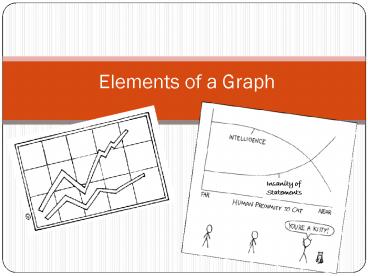Elements of a Graph - PowerPoint PPT Presentation
1 / 19
Title:
Elements of a Graph
Description:
Elements of a Graph Insanity of Statements Why use a graph? Graphs are very useful tools in science: A graph is used by scientist to organize the facts so they can be ... – PowerPoint PPT presentation
Number of Views:137
Avg rating:3.0/5.0
Title: Elements of a Graph
1
Elements of a Graph
Insanity of Statements
2
Why use a graph?
- Graphs are very useful tools in science
- A graph is used by scientist to organize the
facts so they can be analyzed and conclusions can
be drawn. - Graphs are pictorial representation of recorded
information. - Used to show the relationship between 2 or more
different factors. - Graphs make trends in data easy to see.
- Graphs allow us to predict data that is not
measured.
3
- There are several different types of graphs
- BAR GRAPH
- CIRCLE/PIE GRAPH
- LINE GRAPH
4
Bar Graph
- Used to compare data for several individual items
or events.
Number of pets in Mrs. ONeills block 3 class.
5
Circle or Pie Graph
- Used to display data that are parts of a whole.
- Can be compared by percentages or by the size of
the sections/parts.
The different types of pies that the students in
Mrs. ONeills block 3 class enjoy eating.
6
(No Transcript)
7
Line Graphs
Used to show something that is being measured as
it changes over a period of time. Can be used to
predict what will most likely happen next.
8
Line graphs allow us to predict data that is not
measured Extrapolate extend graph along
the same slope, above or below the measured
data.
9
Interpolate predicting data between two
measured points on a graph.
10
Rules for making a line graph
- 1 Assign and label your X and Y axes
- X axis
- Located on the bottom of the graph /horizontal
axis - Shows the most consistent or independent variable
- The independent variable occurs no matter if the
experiment is occurring or not. It is most often
time. - Independent variable is controlled by the
- person conducting the experiment.
11
- Y axis
- Located on the side of the graph /vertical axis
- Shows the variable which is dependent on the
other variable. - The dependent variable is the one that depends
on what happens in the experiment
12
Example
Independent variable - time in
years Dependent variable -population size
13
- 2 Make a scale for each axes based upon
the data collected. - 3 Utilize as much of the graph paper
as possible. - 4 Plot the data points.
14
- 5 Connect the data points with a straight
- edge.
- 6 Give the graph a meaningful title.
- 7 Provide a key if graphing more than one
- set of data points on the same
graph.
15
Graphing Practice
- How far does a soap box car travel after 10
seconds?
Time (seconds) Distance (meters)
0 0
1 2
2 8
3 18
4 32
5 50
6 72
7 98
8 128
9 162
10 200
16
(No Transcript)
17
(No Transcript)
18
Q A
- What is the rate of photosynthesis at 10?C?
- 50
- What is the dependent variable in the graph?
- Rate of photosynthesis
- At what temperature is the rate of photosynthesis
at its highest? - 30 degrees
19
Do these have The same Information On them?

